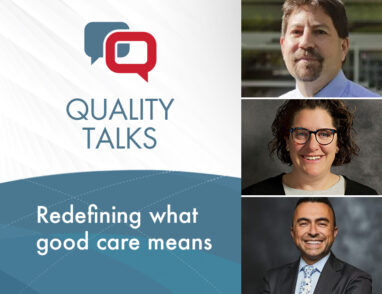Hospital at Home: 7 Lessons
August 11, 2021 · NCQA Communications
One of July’s most popular Quality Innovation Series webinars was Hospital at Home: A Leading Care Model for the Future?
Four enthusiastic and knowledgeable leaders of the hospital-at-home movement outlined how and why care can move out of brick-and-mortar facilities and into patients’ homes.
Seven core lessons emerged from the 90-minute discussion:
1. This could be huge.
The development and scaling of hospital at home is a chance to reimagine health care delivery by centering care in communities and in peoples’ homes.
Centering care in communities includes delivering care in community centers, strong institutions in many parts of the country where access to care may be spotty.
Humana Home Solutions Vice President Dr. Amal Agarwal estimated that up to 35% of Medicare Advantage spending might be addressable at home.
As Mayo Clinic Platform President John Halamka explained, hospital at home also “brings the family back into wellness.” This matters because family involvement affects patient satisfaction.
2. It’s not new.
Presenters dispelled any impression participants might have had that hospital at home is a recent idea, formed to take advantage of new payment opportunities.
In fact, hospital at home has developed for decades, mainly in Canada, Australia and Europe.
Dr. Agarwal noted that in the 1930s, up to 40% of care in the U.S. was delivered at home. In an uncanny affirmation of that point, Dr. Halamka pointed out that the roots of Mayo’s at-home services date to the 1930s.
Dr. Agarwal also quoted former CMMI head (and former NCQA Board member), Patrick Conway: “House calls go back to the origins of medicine, but in many ways is the next generation of care.”
3. It touches each part of the Triple Aim.
Johns Hopkins University School of Medicine Professor, Bruce Leff, said hospital at home can have better clinical outcomes, better patient and family care experience and lower costs than traditional hospital care.
He cited three studies, including a 2012 meta-analysis, to back his claim.
Dr. Halamka shared a 2012 meta-analysis showing the Mayo Clinical Platform’s double-digit improvements in mortality, significant cost reduction and higher patient satisfaction.
4. Acuity matters.
Medically Home Executive Chairman Raphael Rakowski emphasized that acuity is the most important determinant of hospital at home.
“To reliably move patients into a hospital-at-home platform requires a high acuity platform and a high acuity capability,” he said.
That doesn’t mean that hospital at home is right for very sick patients. Patients who need to be in an ICU should stay there.
Patients who aren’t sick enough to be hospitalized are not right for hospital at home, either.
The best population for hospital at home is in the sizeable middle range of acuity. Patients in this range represent “up to 30% of hospital discharges,” said Rakowski.
5. COVID gave it a boost.
Dr. Leff, who has worked for decades in and around hospital at home, said that it “exponentially took off in the wake of COVID, with the CMS acute hospital care waiver.”
The waiver’s purpose is to free up hospital beds for COVID patients. To apply, a hospital attests that it has the capacity and competence to provide hospital-at-home care.
Dr. Halamka elaborated:
“COVID…has given us what we believe are going to be sustained changes in the legal and regulatory landscape. That means that, yes, we can scale this to many more patients. And it will be reimbursed appropriately. And licensure relaxation will ensure that our combination of virtual care and on-prem [on-premises] care will work in perpetuity.”
6. It has equity implications.
Presenters’ comments on what hospital at home means for diversity, equity and inclusion were… well, diverse.
Dr. Leff noted that hospital at home is well researched and evidence-based—in aggregate. Insight into its performance among different racial or ethnic groups, however, is scant.
He lamented that knowledge gap. “These are the kinds of data that we need to be collecting on a global basis.” (We agree about the importance of knowing demographic details, which is why we’ve moved to stratify HEDIS measures by race and ethnicity.)
Other presenters’ observations about equity emphasized economics and geography.
“We think about bias, fairness, equity for those who don’t have a home, for those who don’t have a home with broadband, for those who don’t have a home that’s safe. We’ve actually used hotels and developed a care hotel model,” reported Dr. Halamka.
Rakowski noted that in thinly populated areas such as southeastern Oklahoma, the biggest disparity is access to care—regardless of race or ethnicity.
He went on to say, of rural areas:
“It’s a logistics challenge when you disperse a population, and you don’t have the benefit of scale and concentration. You cannot rapidly or even effectively consume or pay for the resources necessary to support a facility-based model. Decentralization [such as through hospital at home] is the only financial mechanism to deal with health equity and health delivery at scale.”
7. Follow the tractors.
Dr. Halamka used an accessible and memorable analogy to outline the long-term possibilities for hospital at home.
He explained that the tractor manufacturing company John Deere transformed itself into a data company by covering its tractors with sensors. The sensors report back information about the weight and volume of crops that customers harvest—soybeans, for example. The predictive value of the information reported to John Deere is so high that the data are now used to forecast soybean prices.
Likewise, Americans are filling their homes and strapping to their bodies millions of behavioral and biometric sensors.
“We are instrumenting homes with sensors to gather patient data that we can use to understand not only that patient’s progression, but aggregating and analyzing that data [to] understand the progression of similar patients,” said Halamka.
The webinar included about 30 minutes of Q&A, facilitated by gerontologist and NCQA Senior Research Scientist Caroline Blaum.
Anyone interested in an intriguing discussion of health care’s future should watch the program.








